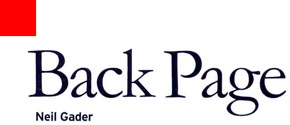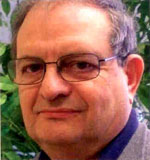
August 2010

President and Founder, Nola Loudspeakers
 What ignited your passion for high-end stereo? At what age? And
did it come from the music side or the electronics side?
What ignited your passion for high-end stereo? At what age? And
did it come from the music side or the electronics side?My passion for high-end stereo came from the music side. I studied piano for 12 years. When I was young, my mother regularly took me to the old Met. I played piano and percussion in high school and in various school bands and orchestras. I guess the sound of live music was instilled in me at an early age.
What was the system you dreamed about as a teenager?
As a teenager I hung out at Leonard Radio on Cortland Street in NYC. The dream system at that time was Marantz electronics driving Bozak Concert Grands (all Alnico magnets - ha!). Ampex tape player, as well.
How do you define the high end to the uninitiated?
To me it is more about the goals than hardware and price tags. True high-end equipment will attempt to portray music instead of sound. This is not a function of price, as we have a lot of gear that produces sound and no music, even at high prices.
What attracted you to the loudspeaker side of audio rather than say electronics or turntables?
I think loudspeakers fascinated me. In the 50s, loudspeakers were mostly DIY. I remember building a pair of 12-cubic-foot bass-reflex enclosures for the Stentorian 12" coax speakers I had saved up for by selling records retail while in high school. After a while, I became bothered by the top-end, so I replaced it with two Wharfedale super three-cone tweeters on a separate baffle. I built my first simple crossover - winding air-core coils, etc. That got me hooked on building speakers.
You gained an enviable reputation designing important speakers for both Dahlquist and Alón. How has that experience informed your current work?
The Dahlquist experience reinforced my own concepts about loudspeaker priorities. That is the idea that the midrange is most important, since without a great midrange there is no music. The DQ10 was a speaker that actually had four of its five drivers contributing to midrange quality. This is in contrast to shooting for the widest possible bandwidth in a design and sacrificing midrange quality or a coherent presentation. In the DQ10, the dipole mid was only used over a narrow range. When Marilyn and I started Alón in 1991, I wanted to expand this to cover the entire midrange. Now, with Nola, for the first time we have a company where we can control all aspects that affect sound quality.
What is the biggest innovation you've seen in your field in the last 10 years?
There has been a lot of innovation in audio in the last 10 years. However, much of the progress is aimed at convenience rather than quality improvements. But we are really talking about two different things. We have much better component parts now with which to build loudspeakers at much higher quality levels. But it is difficult to define progress without defining a goal. My goal is to come as close as possible to narrowing the gap between "live" and reproduced music. We therefore tend to embrace technologies that best serve that goal - be they old or new.
Best "how to" advice to a person about to assemble his first high-end system?
In assembling a first high-end system, pay attention to midrange reproduction. We all know the sound of "live" voices, as we hear them daily. Use natural voice reproduction as a guide. Even a modest system can be convincing in the midrange, and this will serve you well over time.
What side of the argument do you come down on - analog or digital?
At the last two shows we have been using 15" open-reel analog tape in addition to fine digital. The reason for this is that analog seems to elucidate the progress we are making in loudspeakers better and faster. Analog provides a better emotional connection with the listener. This is important at a show, especially where there is limited listening time.
Are you surprised at the resiliency of vinyl in a digital marketplace?
I am surprised by very little at my age. From the next room, Marilyn can always tell that I am playing vinyl rather than digital.
What are the greatest challenges confronting the high end?
One of the great challenges is demonstrating the superiority of a good high-end system compared to the ubiquitous iPod and then selling the idea that this difference is musically important to the listener over a lifetime.
What still inspires you about your work?
The challenge remains to improve the loudspeakers - to come ever closer to the "live" experience. This is what drives Nola loudspeakers and me.